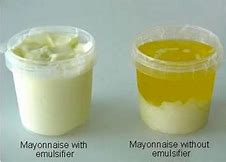The impact of emulsifiers affect food quality
Emulsifiers: Trick Components for Achieving Perfectly Combined Solutions
Emulsifiers play an important duty in developing stable mixtures of immiscible fluids, such as oil and water. Their distinct residential properties enable them to reduce surface tension, which is important for harmony in various formulas. Recognizing the differences in between artificial and natural emulsifiers can affect product top quality considerably. As industries progressively look for to improve structure and life span, the choice procedure for the best emulsifier comes to be critical. What variables should be thought about in this vital choice?
Recognizing Emulsifiers: What They Are and Exactly how They Function
Emulsifiers may appear like a simple enhancement to formulations, they play a crucial duty in maintaining mixes of ingredients that normally do not mix well, such as oil and water. These substances function by decreasing surface stress at the interface in between immiscible liquids, permitting them to mix more uniformly. Emulsifiers contain both hydrophilic (water-attracting) and lipophilic (oil-attracting) buildings, which enable them to secure themselves at the boundary of both phases. By doing so, they produce a safety barrier that stops the droplets of one liquid from coalescing right into larger masses, thus keeping a stable emulsion. The effectiveness of an emulsifier relies on its molecular framework, which influences its ability to support mixtures. In different applications, from food to cosmetics, emulsifiers assure a consistent texture and appearance, improving both performance and customer allure. Their significance can not be overstated in attaining well-blended formulations.
Types of Emulsifiers: All-natural vs. Artificial
Emulsifiers can be generally categorized right into two kinds: all-natural and artificial, each offering unique advantages and applications. All-natural emulsifiers, originated from plant or animal sources, consist of lecithin, periodontal, and casein arabic (emulsifiers). These emulsifiers are often preferred in organic and clean-label products because of their very little handling and biocompatibility. Their gentle nature makes them appropriate for delicate formulas, specifically in food and cosmetics

On the various other hand, artificial emulsifiers such as mono- and diglycerides, and polysorbates are made with chemical processes. They are frequently made use of in commercial applications as a result of their stability and performance in creating emulsions. Synthetic emulsifiers typically display premium efficiency in extreme conditions, such as high temperatures or differing pH degrees. The choice between synthetic and natural emulsifiers mostly depends on the details solution requirements, governing factors to consider, and customer preferences, affecting their efficient application in various industries.
Functions of Emulsifiers in Food and Cosmetic Solutions
The function of emulsifiers prolongs past plain stablizing; they are essential in attaining the preferred appearance, texture, and shelf life of food and cosmetic items. In food solutions, emulsifiers aid blend oil and water, creating smooth and consistent textures necessary for sauces, dressings, and dairy items. They minimize surface tension, boosting the security of emulsions, which protects against separation and extends quality.
In cosmetics, emulsifiers guarantee that active ingredients, such as oils and water, mix seamlessly, enhancing and supplying a positive feeling application. emulsifiers. They add to the product's thickness and spreadability, crucial for creams, creams, and serums. In addition, emulsifiers can envelop energetic components, improving their distribution and efficiency in solutions. By controlling structure and boosting sensory attributes, emulsifiers play a crucial duty in meeting customer assumptions in both food and cosmetic sectors, assuring products are not only appealing however additionally functionally reliable
Choosing the Right Emulsifier for Your Item

In addition, the target application-- whether for food, cosmetics, or pharmaceuticals-- will certainly affect the option. Food-grade emulsifiers must abide with safety regulations, while cosmetic emulsifiers might need skin compatibility. Reviewing factors such as HLB (Hydrophilic-Lipophilic Equilibrium) assists in predicting emulsifier behavior in specific formulations. Inevitably, an extensive evaluation of both regulative considerations and functional demands is necessary to pick the most efficient emulsifier, making certain the end product meets the desired quality and security requirements.
:max_bytes(150000):strip_icc()/eating-well-emulsifier-dressings-3021330094034a48961553c1a8aea356.jpg)
Tips for Effective Emulsion Development and Stability
Attaining effective emulsion formation and stability requires cautious attention to numerous vital factors. The option of emulsifier plays a pivotal function; it ought to be compatible with the oil and water phases to guarantee efficient stabilization. Second, the proportion of oil to water have to be well balanced, as an inappropriate ratio can lead to instability. Third, the mixing process should be regulated; high shear mixing can assist attain smaller sized bead sizes, improving stability.
Temperature level likewise affects emulsion stability; preserving ideal temperatures throughout formulation protects against premature splitting up. Additionally, including stabilizers such as thickeners can even more improve thickness, minimizing the likelihood of stage splitting up. Performing comprehensive security tests after solution will certainly help identify possible concerns, enabling for modifications prior to last manufacturing. By sticking to these standards, formulators can achieve dependable and regular solutions that preserve their desired properties in time.
Frequently Asked Inquiries
Can Emulsifiers Be Made Use Of in Vegan Formulations?
Yes, emulsifiers can be utilized in vegan solutions. Lots of plant-based emulsifiers, such as lecithin from soy or sunflower, offer efficient blending without animal-derived active ingredients, making them suitable for a selection of vegan products.
What Prevail Irritants in Emulsifiers?
Common allergens in emulsifiers consist of soy, dairy, and eggs, as particular emulsifiers are stemmed from these resources. Additionally, some people might respond to ingredients or chemicals used together discover this info here with emulsifiers in different formulas.

Exactly How Do Emulsifiers Influence Shelf Life of Products?
Emulsifiers improve item stability by protecting against separation of active ingredients, consequently expanding life span. They reduce perishing triggered by microbial growth and oxidation, bring about prolonged quality and improved quality in various food and aesthetic formulas.
Exist Any Type Of Health And Wellness Problems Related To Emulsifiers?
Research study suggests possible health and wellness problems related to emulsifiers, consisting of gut microbiome changes and swelling. While governing bodies normally consider them secure, recurring studies remain to discover long-term results on health and total health.
Can Emulsifiers Improve Flavor or Scent in Formulations?
Emulsifiers can enhance flavor and scent in formulas by boosting component diffusion and security. This causes a more consistent product, allowing tastes to blend efficiently, inevitably causing a more enjoyable sensory experience for consumers.
Emulsifiers may appear like a simple enhancement websites to solutions, they play an important role in stabilizing mixes of components that commonly do not mix well, such as oil and water. In food solutions, emulsifiers assist blend oil and water, developing uniform and smooth appearances essential for sauces, dressings, and dairy items. Food-grade emulsifiers ought to conform with safety regulations, while aesthetic emulsifiers may call for skin compatibility. Usual allergens in emulsifiers include soy, dairy, and eggs, as specific emulsifiers are obtained from these resources. Emulsifiers can enhance taste and fragrance in solutions by enhancing active ingredient diffusion and stability.